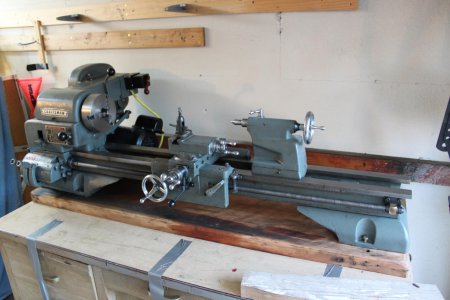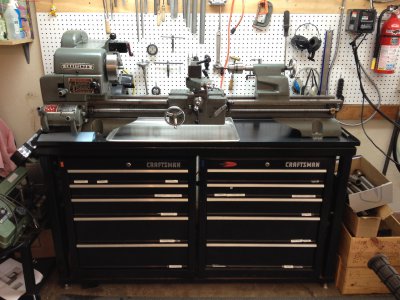- Joined
- Jan 25, 2015
- Messages
- 2,558
Generally, I find the Atlas lathes are put down by professionals and sort "damned with faint praise" by hobbyists (IE:it's good enough).
Now, I still haven't picked mine up (10X36 or maybe a 42, remains to be seen) but I would like to address any "flexibility" items while I'm cleaning, restoring and setting it up.
I say flexibility since that seems to be the major thing that is usually pointed out. Is it the ways that are "flexible"? or is it in the cross slide? the head?
Is it the width of the ways perhaps?
Or perhaps it's only "flexible" when compared to a 3000 lb dedicated shop type lathe?
I need to build a stand for the atlas and I was thinking I like a lot of the things this gent mentions with a "beam" mounting:
[video=youtube;ztA-0KSi1FM]https://www.youtube.com/watch?v=ztA-0KSi1FM[/video]
I like the ease of access to the chip tray, I like the added space under the hand wheels, I like the way it manages dripping oil (or coolant if I ever build that) and if it actually does add a degree of stiffness to the lathe for greater accuracy, I'm sold.
I will have to build a stand for my atlas either way. The guy I'm buying it from has it mounted on a rather nasty looking 2x4 and plywood arrangement and I don't think it even comes with the lathe. I'd probably be tossing it even if it did.
I was also thinking of eventually changing out the "lantern" tool holder for a QCTP, but am unsure if that wold do anything for accuracy or not. I'm not doing production stuff so ease and speed of changing tools is not a high priority, but would probably be a welcome addition in the convenience dept. Would be a while before it happens anyways, the budget can only take so much stretching and I'm buying a new welder this month also (Millermatic 211).
I'm not looking to turn out high precision work with the old atlas, but I would like to get the most out of it that I can. If I can do that while building a stand, more the better!
I know that's kind of a broad topic post, but any input or explanation on why the Atlas seems to have such a bad wrap (and ways of fixing it) would be welcome.
Cheers
Now, I still haven't picked mine up (10X36 or maybe a 42, remains to be seen) but I would like to address any "flexibility" items while I'm cleaning, restoring and setting it up.
I say flexibility since that seems to be the major thing that is usually pointed out. Is it the ways that are "flexible"? or is it in the cross slide? the head?
Is it the width of the ways perhaps?
Or perhaps it's only "flexible" when compared to a 3000 lb dedicated shop type lathe?
I need to build a stand for the atlas and I was thinking I like a lot of the things this gent mentions with a "beam" mounting:
[video=youtube;ztA-0KSi1FM]https://www.youtube.com/watch?v=ztA-0KSi1FM[/video]
I like the ease of access to the chip tray, I like the added space under the hand wheels, I like the way it manages dripping oil (or coolant if I ever build that) and if it actually does add a degree of stiffness to the lathe for greater accuracy, I'm sold.
I will have to build a stand for my atlas either way. The guy I'm buying it from has it mounted on a rather nasty looking 2x4 and plywood arrangement and I don't think it even comes with the lathe. I'd probably be tossing it even if it did.
I was also thinking of eventually changing out the "lantern" tool holder for a QCTP, but am unsure if that wold do anything for accuracy or not. I'm not doing production stuff so ease and speed of changing tools is not a high priority, but would probably be a welcome addition in the convenience dept. Would be a while before it happens anyways, the budget can only take so much stretching and I'm buying a new welder this month also (Millermatic 211).
I'm not looking to turn out high precision work with the old atlas, but I would like to get the most out of it that I can. If I can do that while building a stand, more the better!
I know that's kind of a broad topic post, but any input or explanation on why the Atlas seems to have such a bad wrap (and ways of fixing it) would be welcome.
Cheers
Last edited:


